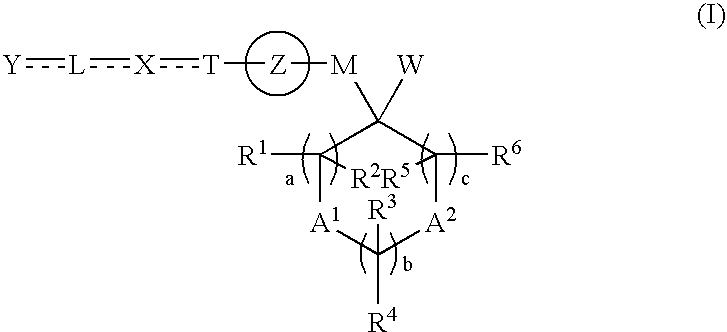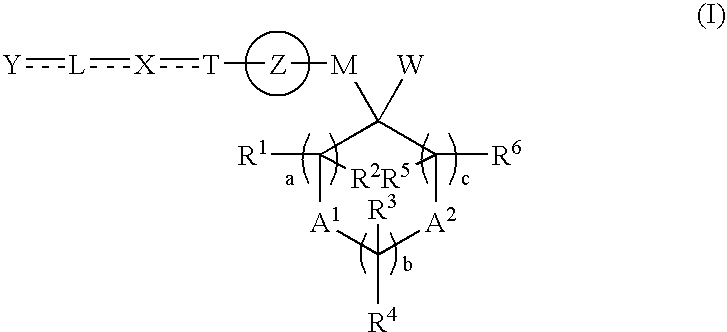Cyclic compound and ppar agonist
a cyclic compound and agonist technology, applied in the field of new carboxylic acid compounds, can solve the problems of severe hypoglycemia, social problems, and limited use of such medicines
- Summary
- Abstract
- Description
- Claims
- Application Information
AI Technical Summary
Benefits of technology
Problems solved by technology
Method used
Image
Examples
reference example 1
Methyl 2-[(3-{[(t-butoxycarbonyl)amino]methyl}-4-methoxyphenyl)(hydroxy)methyl]tetrahydro-2-furancarboxylate
A solution of 2.60 g of methyl tetrahydro-2-furancarboxylate in 10 ml of tetrahydrofuran was added dropwise to 20 ml of sodium bis(trimethyldisilylamide) (1 M solution in tetrahydrofuran) cooled to −75° C. under an atmosphere of nitrogen gas, and the reaction mixture was stirred for 30 minutes. A solution of 2.65 g of t-butyl N-(5-formyl-2-methoxybenzyl)carbamate in 20 ml of tetrahydrofuran was added dropwise, and the mixture was stirred further for 1 hour. 200 ml of saturated aqueous ammonium chloride was added, and the mixture was extracted with 200 ml of ethyl acetate. The organic layer was washed with 100 ml of brine, dried over magnesium sulfate and then concentrated. The residue was purified by silica gel column chromatography, to give 1.934 g of the title compound as a colorless powder.
1H-NMR(CDCl3): 1.44(s, 9H), 1.73-1.88(m, 2H), 1.94-2.02 and 2.16-2.23(ddd, J=7.3...
reference example 2
Methyl 2-[3-(ammoniomethyl)-4-methoxybenzyl]tetrahydro-2-furancarboxylate chloride
To a solution of 1.934 g of methyl 2-[(3-{[(t-butoxycarbonyl)amino]methyl}-4-methoxyphenyl)(hydroxy)-methyl]tetrahydro-2-furancarboxylate in 50 ml of trifluoroacetic acid was added 8 ml of trimethylsilane at 0° C., and the mixture was stirred at room temperature for 60 hours. The reaction mixture was concentrated, and 20 ml of hydrochloric acid (1N) and 10 ml of diisopropyl ether were added. The aqueous layer was adjusted to pH 12 with sodium hydroxide (SN) and extracted with 20 ml of ethyl acetate for two times. The organic layers were combined, 5 ml of hydrogen chloride (4N solution in ethyl acetate) was added, and the mixture was-concentrated. To the residue was added 40 ml of ethyl acetate and the mixture was concentrated again, to give 1.590 g of the title compound as a waxy colorless solid.
1H-NMR(CDCl3): 1.69-1.84(m, 2H), 1.87-1.95(ddd, J=7.3, 7.6, 12.6 Hz, 1H), 2.19-2.15(ddd, J=6.5, 7.1, 12...
reference example 3
(3-{[(t-Butoxycarbonyl)amino]methyl}-4-methoxybenzoyl)-1-cyclopropanecarboxylic acid
Under an atmosphere of nitrogen gas, a solution of 3.16 g of t-butyl N-(5-bromo-2-methoxybenzyl)carbamate in 40 ml of tetrahydrofuran was cooled to −75° C. n-Butyllithium (1.6 M solution in hexane) was added while keeping the internal temperature at −70° C. or below, and the mixture was stirred for 30 minutes. After addition of a solution of 1.96 g of 6,6-dimethyl-5,7-dioxaspiro[2.5]octane-4,8-dione in 10 ml of tetrahydrofuran, the mixture was stirred for 2 hours. 50 ml of 5% aqueous ammonium chloride was added, and the mixture was adjusted to pH 2 with concentrated hydrochloric acid and then extracted with 300 ml of ethyl acetate. The organic layer was washed with 50 ml of brine, dried over magnesium sulfate and concentrated. The residue was purified by silica gel column chromatography, to give 1.069 g of the title compound as a colorless powder.
1H-NMR(CDCl3): 1.44(s, 9H), 1.53(m, 2H), 1.65(m, ...
PUM
| Property | Measurement | Unit |
|---|---|---|
| Electrical resistance | aaaaa | aaaaa |
| Energy | aaaaa | aaaaa |
Abstract
Description
Claims
Application Information
 Login to View More
Login to View More - R&D
- Intellectual Property
- Life Sciences
- Materials
- Tech Scout
- Unparalleled Data Quality
- Higher Quality Content
- 60% Fewer Hallucinations
Browse by: Latest US Patents, China's latest patents, Technical Efficacy Thesaurus, Application Domain, Technology Topic, Popular Technical Reports.
© 2025 PatSnap. All rights reserved.Legal|Privacy policy|Modern Slavery Act Transparency Statement|Sitemap|About US| Contact US: help@patsnap.com



